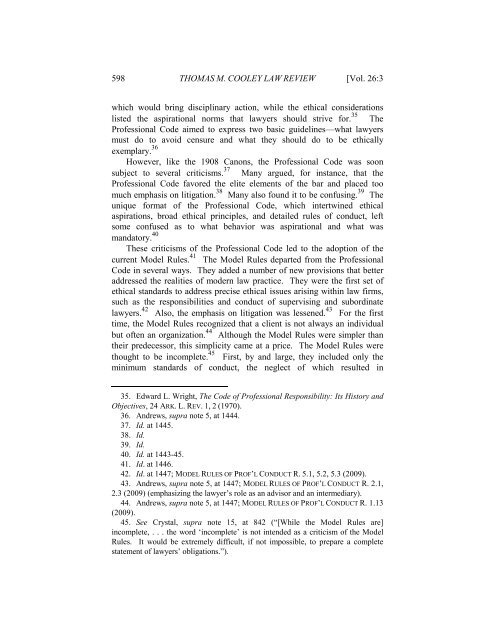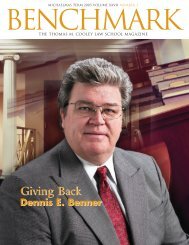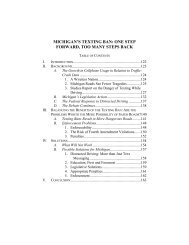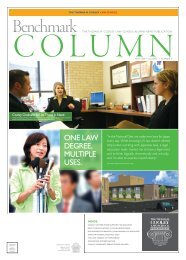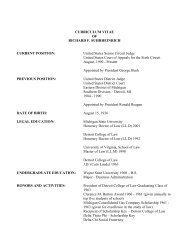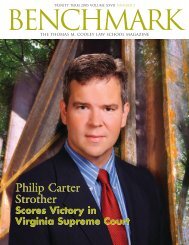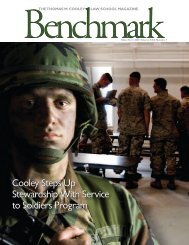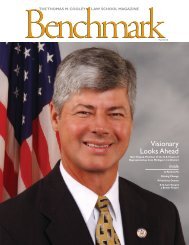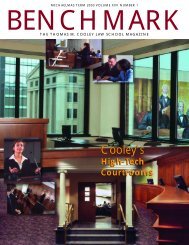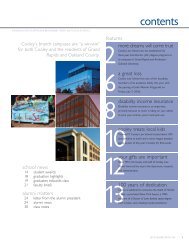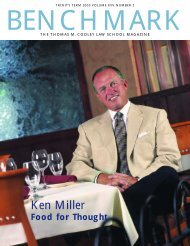Beyond The Model Rules - Thomas M. Cooley Law School
Beyond The Model Rules - Thomas M. Cooley Law School
Beyond The Model Rules - Thomas M. Cooley Law School
Create successful ePaper yourself
Turn your PDF publications into a flip-book with our unique Google optimized e-Paper software.
598 THOMAS M. COOLEY LAW REVIEW [Vol. 26:3which would bring disciplinary action, while the ethical considerationslisted the aspirational norms that lawyers should strive for. 35 <strong>The</strong>Professional Code aimed to express two basic guidelines—what lawyersmust do to avoid censure and what they should do to be ethicallyexemplary. 36However, like the 1908 Canons, the Professional Code was soonsubject to several criticisms. 37 Many argued, for instance, that theProfessional Code favored the elite elements of the bar and placed toomuch emphasis on litigation. 38 Many also found it to be confusing. 39 <strong>The</strong>unique format of the Professional Code, which intertwined ethicalaspirations, broad ethical principles, and detailed rules of conduct, leftsome confused as to what behavior was aspirational and what wasmandatory. 40<strong>The</strong>se criticisms of the Professional Code led to the adoption of thecurrent <strong>Model</strong> <strong>Rules</strong>. 41 <strong>The</strong> <strong>Model</strong> <strong>Rules</strong> departed from the ProfessionalCode in several ways. <strong>The</strong>y added a number of new provisions that betteraddressed the realities of modern law practice. <strong>The</strong>y were the first set ofethical standards to address precise ethical issues arising within law firms,such as the responsibilities and conduct of supervising and subordinatelawyers. 42 Also, the emphasis on litigation was lessened. 43 For the firsttime, the <strong>Model</strong> <strong>Rules</strong> recognized that a client is not always an individualbut often an organization. 44 Although the <strong>Model</strong> <strong>Rules</strong> were simpler thantheir predecessor, this simplicity came at a price. <strong>The</strong> <strong>Model</strong> <strong>Rules</strong> werethought to be incomplete. 45 First, by and large, they included only theminimum standards of conduct, the neglect of which resulted in35. Edward L. Wright, <strong>The</strong> Code of Professional Responsibility: Its History andObjectives, 24 ARK. L. REV. 1, 2 (1970).36. Andrews, supra note 5, at 1444.37. Id. at 1445.38. Id.39. Id.40. Id. at 1443-45.41. Id. at 1446.42. Id. at 1447; MODEL RULES OF PROF’L CONDUCT R. 5.1, 5.2, 5.3 (2009).43. Andrews, supra note 5, at 1447; MODEL RULES OF PROF’L CONDUCT R. 2.1,2.3 (2009) (emphasizing the lawyer’s role as an advisor and an intermediary).44. Andrews, supra note 5, at 1447; MODEL RULES OF PROF’L CONDUCT R. 1.13(2009).45. See Crystal, supra note 15, at 842 (“[While the <strong>Model</strong> <strong>Rules</strong> are]incomplete, . . . the word ‘incomplete’ is not intended as a criticism of the <strong>Model</strong><strong>Rules</strong>. It would be extremely difficult, if not impossible, to prepare a completestatement of lawyers’ obligations.”).


